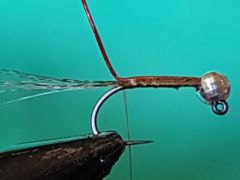I was attracted to this fly because it is made of two of my favourite fly tying materials UV Ice dubbing and CDC.
It has looked like a winner since I first saw this fly and it has not let me down.
Designed by, as I understand it, Craig McDonald it is a very popular fly in Europe and fast developing a following in Australia and New Zealand.
I generally fish my 2 fly trout leader when fishing rivers and more often that not this fly will get a swim at some time during every session.
Materials
| Hook |
Thread |
Weight |
Tail |
Rib |
Body and thorax |
Hackle |
Collar |
| Size 12 # or #18 jig. Hanak, Knapek, Fulling Mills, Partridge or similar |
Uni or Danville’s brown 6/0 |
Silver slotted tungsten bead 3.0mm or 3.5mm |
Coq de Lion brown cock hackle fibres |
UTC ultra red in Medium size |
Hairline UV brown or Siman 02UV Brown dubbing |
Brown CDC hackle |
Hairline UV brown or Siman 02UV Brown dubbing |
Process
| A |
- Most beads have a large opening, albeit round or slotted as in this case, at one end and a smaller opening at the other. Slide a bead over the point of the hook small opening first and manoeuvre it along the shank and onto the jig post until it sits directly behind the eye of the hook with the slot facing upward.
[member Link=”p=345″ Title=”Beads for eyes and or weight”]
- Wind the thread in touching turns to the bend of the hook.
[member Link=”p=10018″ Title=”Understanding hooks”]
|
 |
| B |
- Tie in a tail about as long as the hook consisting of 8-10 Coq de Leon hackle fibres.
|
 |
| C |
- Insert the end of a length of red copper wire into the slot of the bead and tie it in all the way along the top of the hook shank to the bend of the hook.
|
 |
| D |
- Dub in a body starting thin at the tail end and increasing in girth until it stops far enough behind the bead to leave room to comfortably tie in the CDC hackle.
|
 |
| E |
- Wind the coper wire forward creating 4 or 5 equal body segmemnts along the body of the fly.
- Take an extra 2 tight turns of the copper wire in the space left for the CDC hackle.
[member Link=”p=2656″ Title=”Body segments on flies”]
|
 |
| F |
- Worry the excess copper wire off.
 |
|
| G |
- Select a CDC hackle that has barbules that are at least as long as the hook.
shank. It’s OK if they are too long as step (I) deals with shortening the length of the barbules if required.
- Tie a CDC hackle in by the tip.
|
 |
| H |
- Trim away the tip of the CDC hackle.
- Take 2 turns of the CDC hackle in front of the body and secure it in place with a few wraps of thread.
|
 |
| I |
- If the CDC hackle barbules are too long wet the tips of you fingers on your left hand and gather up all the hackle barbules tips.
- Change the grip of the bunch of hackle barbules to the right hand and using the left pinch off the hackle barbule tips that were previously held by that hand.
[member Link=”p=1738″ Title=”Other forms of legs on flies”] |
 |
| J |
- Take just a little dubbing and dub in a collar between the CDC hackle and the bead.
- Whip finish behind the bead, trim the thread and varnish the thread behind the bead.
|
 |











